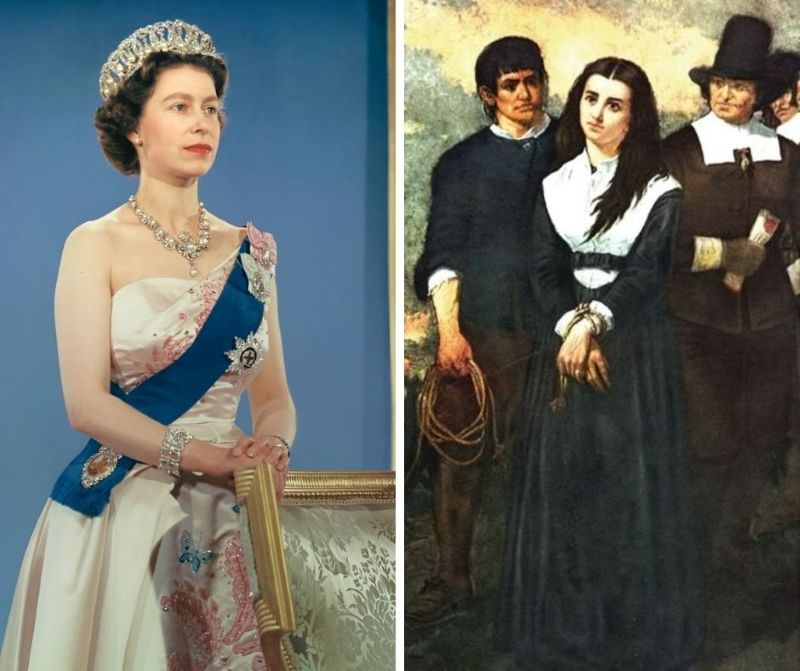In 1950, Salem resident John Beresford Hatch began a crusade to convince the British government to clear the names of the convicted Salem Witch Trials victims.
Hatch first became interested in the Salem Witch Trials when he met Alfred Putnam Goodell, historian and owner of the Old Witch Jail and Dungeon attraction, in 1935.
Hatch was a technical writer at the time but became fascinated by Goodell’s writings on the topic. Goodell later hired Hatch to help him run the Old Witch Jail and Dungeon attraction.
Then, in 1950, Hatch came across the writings of an obscure New York historian who challenged the legality of the trials, which inspired Hatch to begin his one-man crusade.
Hatch felt that since the British government never authorized the Salem Witch Trials in the first place and never ratified the 1711 bill passed by the Massachusetts legislature, which cleared the names of some of the convicted, both the trials and the bill were therefore invalid.
After sending numerous letters to Queen Elizabeth at Buckingham Palace and the Prime Minister’s office and receiving no answer, in 1955, Hatch sent a letter to the British Consul General in Boston, stating:
“At this moment in history, it might be a fine gesture on the part of the British government to fully exonerate…all who went to their deaths.”
Three months later, the British Embassy in Washington, D.C., replied and stated that the British government no longer had jurisdiction over the Salem Witch Trials.
In response, Hatch filed a petition with the Massachusetts legislature asking them to assist in the matter.
In 1957, the Massachusetts legislature passed a bill clearing the name of Ann Pudeator, but Hatch felt this bill was also invalid because he believed the Commonwealth of Massachusetts couldn’t legally exonerate victims tried under colonial law, as he told the Boston Globe in 1959:
“There was a resolve passed in 1957 and signed by Gov. Furcolo to exonerate one of the supposed witches, Ann Pudeator, who was hanged. It was sponsored by a descendant, a Salem judge. But I feel it’s a defective measure, because, if you read it, you’ll find it really doesn’t forgive her or any of the other witches. It should be repealed.”
Hatch filed his petition, which called on the state legislature to pressure Congress, the British Ambassador, and the United Nations to clear the names of all the convicted witches, multiple times in 1957, 1958, 1959, and 1960, but to no avail. The petition stated:
“Some sporadic attempts…by several Massachusetts legislatures…to exonerate certain selected ‘witches’…are obviously inadequate and unauthorized. Unless decisive and appropriate action is taken here and now…the aimless babble of legalistic gobbledy-gookians may prevail ad infinitum.”
Hatch even appeared on a BBC program and threatened to take his case to the United Nations. In 1958, Hatch wrote to Queen Elizabeth again, asking her to “pardon every blessed one. By such a good example, surely the whole world would rejoice, being made fully aware that justice late is better than justice never.” The queen did not reply.
In 1959, Hatch wrote to Prime Minister Macmillan and suggested a meeting with him on Gallows Hill in Salem to settle the matter but, again, failed to receive a response.
Hatch then decided he should meet with the Queen in person and asked Representative Thomas J. Lane to approve a request with the State Department to visit Britain and meet her, but the State Department declined the request, stating that it wouldn’t be appropriate.
In 1960, Hatch submitted two petitions to Congress; one asked to repeal the 1957 bill, and the other was his original petition asking Congress to pressure the British government to clear the convicted witches’ names.
“You can’t bury history,” Hatch was quoted saying in an article in the Reading Eagle. “If the trials were fallacious, unjust and illegal, then the deaths of these innocent victims were a crime, and an infamous one. With one stroke of her pen Queen Elizabeth could write a morally and legally finis to a terrible judicial wrong.”
Neither petition amounted to anything, and Hatch was never able to persuade the British government to clear the convicted witches’ names. It appears that after pursuing the matter for 10 years, Hatch finally admitted defeat.
In 1963, Hatch self-published a book about his attempts to clear their names, which was titled Salem Witchcraft: Fact or Fiction?
In 1977, Hatch sent a letter to the editor of The Telegraph in Nashua, NH, in response to a recent article in the paper about the Salem Witch Trials.
In his letter, Hatch corrected some of the inaccuracies he read in the article and identified himself as an expert in the subject who had devoted his life to clearing the witches’ names, which, he admitted, “may be considered a ‘lost cause.’”
Sources:
Collier, Frank. “Move to Clear ‘Witches’ of 1692.” Daily Worker (New York), 18 Feb. 1957, p. 3.
“Salem to Get Back Witches.” The Guardian, 19 Nov. 1958, p. 14.
“English Queen Only Redress in Witchcraft.” The Boston Globe, 14 Feb. 1957, p.11.
“He’s Asking England’s Queen to Clear Mis-Named Witches.” The Boston Globe, 2 Oct. 1962, p. 37.
“Don’t Leave Witches to Heaven, Salem Pardon-Pleaders Urge.” The Boston Globe, 2 Mar. 1959, p. 17.
“New Attempt to Clear 19 Witches.” The Windsor Star, 20 Jan. 1960, p. 47.
“Dear Elizabeth.” Reading Eagle, 21 Aug. 1960, p. 93.
“Salem Witchcraft: Fact or Fiction by John Beresford Hatch.” The Boston Globe, 31 Oct. 1963, p. 13.

